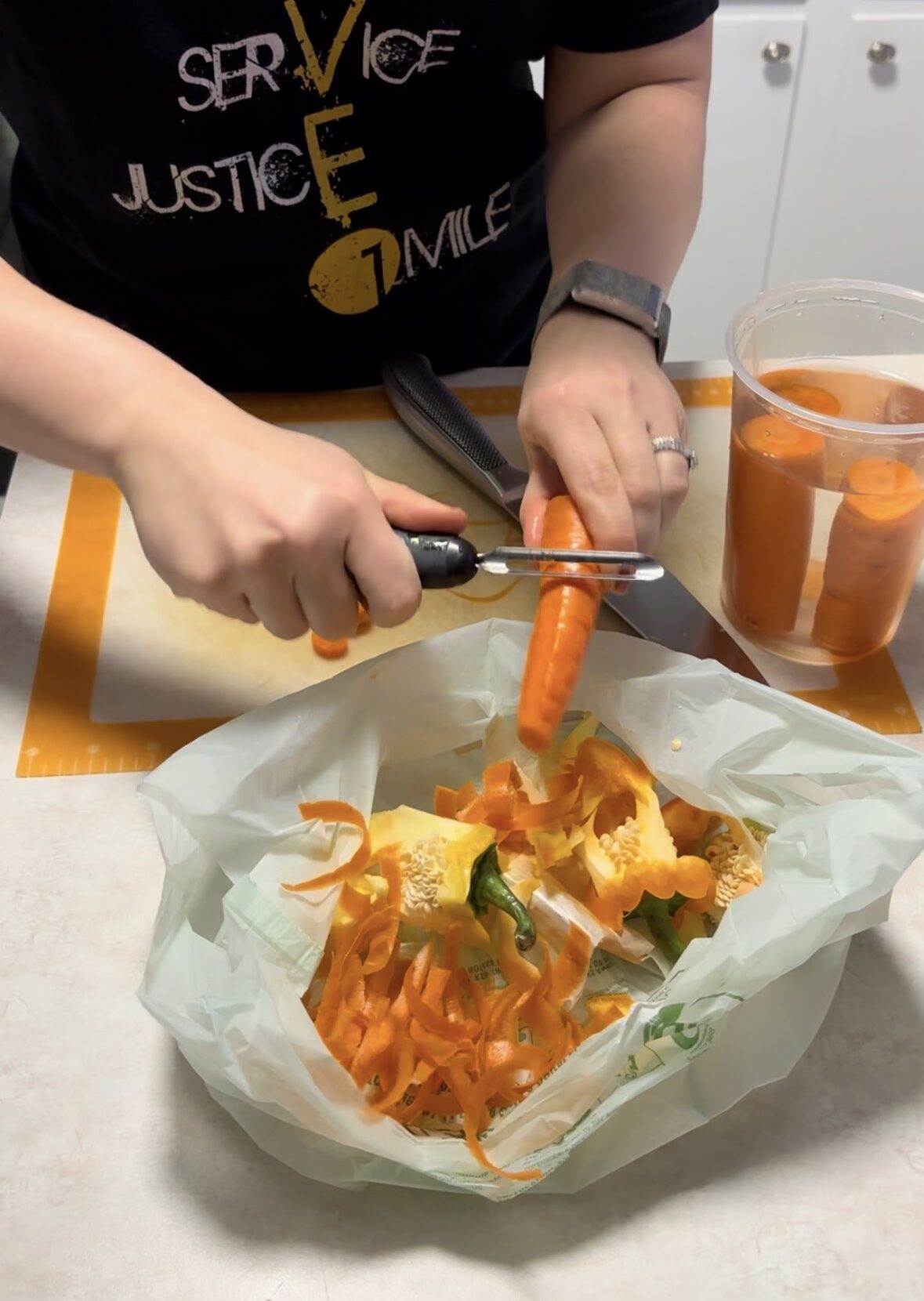The first time I thought about food waste
My first eye-opening experience with food waste was the summer after my freshman year of college. I was working part time at a summer educational program for elementary aged kids in a city close to home and was also working part time at a pizza buffet restaurant. During the day I’d spend time with kids who often struggled to know where their next meal would come from. During the evenings and weekends I’d spend time watching people gorge themselves on too much cheap pizza.
At the restaurant I was a cutstock. I cut the pizzas as they came out of the oven and stocked the buffet. Part of that job was to consolidate the pizzas, or throw them in the bin below the buffet when the pieces were looking subpar. It was shocking to see how many times the discard bin filled up in a shift and was taken out back to the dumpster. Naturally I just didn’t put the pizza in the bin. I’d leave it on the buffet until a manager walked by and threw it away themselves.
What could I do to prevent food waste?
I immediately started researching what could be done instead of throwing away all this perfectly good pizza (but not good enough for the customers paying $5.99 or $6.99 for endless pizza?). I get it – it’s important to put on a good showing for your customers. But it seemed irresponsible and I wanted to help fix the problem.
I eventually found an organization that had a refrigerated truck to pick up food from restaurants multiple times a week. The organization would distribute it to organizations that were serving the homeless or other food insecure populations. I called them to figure out the details and came up with a proposal for the owner of the restaurant. I presented it to him and he was immediately interested. It took some time to work out the details and ultimately I left the job to go back to college before it was actually implemented, but I hope that things continued in my absence. At that time I didn’t really understand anything about food waste and the environmental impact of it. But I knew I couldn’t justify spending so much time caring about kids living in a city with significant food insecurity and then go to my other job and throw away perfectly good food.
Learning more about food waste
Even up until I started researching and learning more about food waste recently, the only thing I really thought I could do to impact the food waste problem was composting to avoid greenhouse gas emissions. But I’m now realizing there is so much more to the food waste problem locally and globally. I hope you’ll find something new and interesting that you can take back to your own life from today’s post.
Food waste statistics
Let’s start with some mind blowing facts. Maybe you’ve heard these before, but really take some time to sit and think about what each of these statistics mean:
- How much food is wasted in the US? A staggering 35% of the United States food supply is simply classified as waste. This works out to approximately 492 to 1,032 pounds of food waste per person per year.
- Approximately 35-60% of all food wasted is wasted at the point of consumption. The point of consumption includes household waste (you and me) and food service waste (restaurants, grocery stores, etc.)
- If all fossil fuel use was stopped tomorrow, the United States would still not meet the Paris Climate Agreement threshold of a 1.5°C global temperature increase, due to the country’s current food waste trends.
- Food wasted in the United States is estimated to contain enough calories to feed an additional 150 million people. There are only an estimated 35 million people classified as food insecure in the United States.
- If all the global food waste was combined into its own “country”, in 2010 it would have been the third largest greenhouse gas emitter, only behind China and the United States.
Definition of food loss and waste
A lot of those facts seem incomprehensible to me. Let’s dig a little deeper into some details, then we’ll talk through what each of us can do to help combat the problem. For the rest of the post I’m going to refer to FLW, which stands for “Food Loss and Waste”. FLW is essentially defined as food produced for and intended for human consumption, but not actually consumed by humans. Any substance (processed or raw) including drinks is encompassed in the definition of “food”. Food loss typically encompasses food lost in the supply chain before it makes it to the grocery store shelves. Food waste typically encompasses any food that could be consumed, but gets disposed of instead.
Categories of food loss and waste
FLW can be edible or inedible components. Examples of edible components are egg white and yolk, apple skin and flesh, and chicken breast meat. Examples of inedible components are eggshells, apple seeds, and chicken bones. These examples are pretty easy to understand, but some examples are more difficult to categorize due to cultural and social differences. For instance, organ meats are a delicacy in some countries but processing waste in others. Some cultures consume broccoli stalks regularly and others only consume the head of the broccoli regularly. There are many cultural and social differences that vary by community and country. This makes it difficult to have hard and fast rules about what is edible and inedible. One always-true distinction is that you cannot reclassify something like an apple from edible to inedible, just because it grows mold and you cannot eat it after a certain point. It’s still considered edible waste because it could have been eaten earlier. It is a subjective division, for sure. However, it can help focus improvements in a specific area if edible or inedible waste is more common.
The food supply chain
When we think about FLW, we must include the entire supply chain, which is primarily four categories.
- Primary production includes producing the raw food materials through farming.
- Distribution and processing includes any and all packaging, manufacturing steps, and transportation needed to get a specific food onto the shelf at your grocery store.
- Retail includes selling food to the population at a grocery store or farmers market.
- Consumption includes human consumption, or disposal, of food whether it’s at home, a restaurant, etc. If you waste food at the consumption phase, you’re also wasting the energy, water, land, and any other inputs that it took to grow, transport, and package that specific item.
FLW and GHG: the impact of food waste
The EPA compiled a report comparing multiple different research methods and estimates for FLW in the United States. Below is a table summarizing the estimates for various statistics divided into the four supply chain categories.
| Supply Chain Stage | Estimated % of FLW | Estimated % of GHG Emissions from FLW |
| Primary Production | 17-37% | 48% |
| Distribution & Processing | 5-21% | 26% |
| Retail | 6-27% | 22% |
| Consumption | 35-61% | 4% |
The data in the table above shows us the majority of FLW generated in the United States is at the consumption stage. This means the majority is in our control. If we look at where the majority of greenhouse gasses (GHGs) are emitted, we may think only 4% of GHG emissions are within our control. That’s not really true. GHG emissions have a cumulative effect. Because we are the primary FLW generators in the system, we carry a lot of responsibility for everything that had to happen to get the food to us, just so we could waste a third of it.
Other FLW resource impacts
It’s not just GHGs that we need to be concerned about when it comes to FLW. There are a lot of other necessary resources to produce the current amount of food in the United States. According to the EPA report the annual FLW in the US also wastes the following resources (shown in total and on a per person basis). And remember, a lot of this we have control over!
| Impact | Annual Total | Per Person Per Year |
| Agricultural Land Use | 140,000,000 acres | 19,000 sq ft |
| Water Use | 5,900,000,000,000 gallons | 19,000 gallons |
| Pesticide Use | 780,000,000 pounds | 2.5 pounds |
| Fertilizer Use | 14,000,000,000 pounds | 44.5 pounds |
| Energy Use | 664,000,000,000 kWh | 2,140 kWh |
| CO2 Emissions | 170,000,000 MT CO2 | 540 kg CO2 |
Along with carbon dioxide emissions as shown in the above table, there are other GHGs produced in the US food system. 39% of methane emissions and 80% of nitrous oxide emissions stem from the primary food production phase. Both of these GHGs have a higher warming potential than CO2.
What’s next?
How do we fix this massive food waste problem? The United Nations Sustainable Development Goals (SDGs) have some guidance and goals on this topic. Part of SDG 12: “Responsible Production and Consumption” is a sub-goal 12.3. This sub-goal includes decreasing the global food waste by 50% at the retail and consumer level by 2030. The United Nations Environment Programme (UNEP) published a first pass report at estimating the food waste for each country and region. For countries to come up with a strategy to reduce food waste by 50%, it’s important that each country has detailed data indicating where the food waste in their country specifically comes from. UNEP also has a “Food Waste Index” calculation that will evaluate the reduction in food waste over time. Note that here we are only talking about food waste (at the retail and consumer level) and not including food loss that happens earlier in the supply chain.
A global view
Food waste is a major worldwide problem. A quick global comparison shows that 61% of all food waste comes from the household, 26% comes from food service and 13% comes from retail. What I found most interesting in the UNEP report was how low the estimate is for household food waste in the US. The likely scenario for why household waste in the US appears to be so low, is that food service waste is the highest for the US out of all countries in the report. This indicates more meals in the US are consumed through the food service sector rather than the home. Combining household and food service waste in the US makes the total food waste similar to or higher than countries like Australia and the UK.
Steps to reduce food waste
It’s clear this is a global problem. We know there are millions of people globally that do not have enough food. The global population is also projected to continue growing. We also know that food systems contribute significantly to climate change and negative environmental impacts. It’s obvious that we need to make changes, but what can you and I do?
- If you aren’t aware of how much food is wasted in your own household and how much is edible versus inedible, I’d suggest taking an audit! Choose a “standard” week of eating. After each meal, either weigh or take an estimate of how much edible and inedible food you’re tossing. This will help figure out where you may need to focus.
- To prevent throwing away edible food, meal planning and making a specific grocery list can be really helpful. If you know your broccoli will go bad in a few days, incorporate that into your upcoming meals. It can also be helpful to research how to keep your produce fresh for longer. Washing berries in cold water and vinegar and storing them in a sealed bowl at home will make them last longer than keeping them in the store bought container. Consider what you throw away the most and try to find ways to preserve those foods better. You can look into the FoodKeeper app if this is where you find most of your waste. The app will allow you to set calendar reminders for when items will expire. It also provides tips and tricks for preserving various foods for longer. In general, fruits, vegetables, dairy, and eggs are the most wasted according to multiple studies by the EPA and UNEP. If you’re not sure where to focus, I’d start there!
- To prevent throwing away inedible food is a little more complicated, but there are still some things we can do. Have you thought about saving your lemon peels to make a homemade cleaner? Have you thought about freezing your berries, spinach, or whatever else is going bad so you can use them for a smoothie? Have you thought about saving your coffee grounds for your (or your neighbor’s) garden? I follow Carleigh Bodrug (@plantyou) on Instagram. She has so many ideas like saving your onion peels to make onion powder, or making leftover beets into preworkout, that I would never have thought of! This is a great way to get new ideas on how to use your “inedible” food waste. Of course, you’ll always have some level of inedible food waste of which I’d recommend composting, but composting cannot be the only solution – we need to focus on prevention!
- Eat locally and seasonally. Less demand for crops that are out of season in the US means less biodiversity and land loss in other countries to support our needs. To get specific – sugarcane, palm oil, and coffee all have disproportionately high impacts on biodiversity loss in other countries. Focus on sugarcane, palm oil, and coffee that are fair trade certified and responsibly or sustainably sourced.
- Cook more at home. This is generally the healthier option, but also puts you and your family more in control of waste generation. The data shows the US has significant food waste from the food service industry. If we can eat out less while simultaneously being more responsible with food wasted in our households, we will begin to make improvements in FLW as a country.
- If you work in the food system whether it’s at a restaurant, a grocery store, a farm, or a local business with a cafeteria, the USDA website has tips for various industries that are looking to make an impact on FLW. It doesn’t matter if you’re the owner, CEO, manager, or the lowest person in your company. If you take action and initiative, you could make a significant impact on FLW, but also on the community.
- Support farmers, stores and restaurants that implement responsible FLW practices. The USDA has an FLW “Champions” page where companies will commit to halving their FLW by 2030. Consider supporting businesses, particularly grocery stores, that have made this commitment. You can also ask your local businesses how they handle waste if they are not on the USDA list.
- Educate and encourage other people to consider their food waste. Most waste happens at the household level and we need more than one or two households to make a difference. No one can make a change if they’re not aware of the problem and the impact.
SOURCES:









